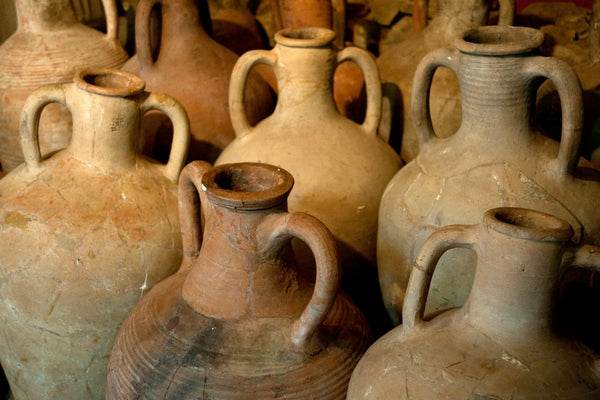
Containers for wine: from ancient times to today ..
Apr 04, 2022
0 comments
In ancient times, stone tubs and leather skins were used as containers to produce wine; subsequently, once it was ready to be consumed, the wine was stored and transported in amphorae, terracotta containers, jars and jars. These were capacious and very heavy containers, but at the same time also very fragile and with a high risk of cracking during transport. The latter, as you can well imagine, took place mostly on wagons and since they had wooden wheels, it was easy for them to jump at every small hole and roughness of the ground, risking damaging the load.

To reach the most distant markets, the containers used most were the jars; they were loaded on the ships, and well sealed, placed in the holds on "beds" of straw and sand. Subsequently, it is believed that the Celtic populations of the Gauls who lived near the forests were skilled master carpenters and made special wooden containers to transport wine. The barrels were then used on a large scale starting from 600 BC. The staves were made of larch and fir wood expertly folded into a circle and closed by interlocking, while the closing rings were made of walnut and willow. To close the interstices between the staves, they used pitch they themselves produced in the ovens with the resin of the spruce trees.

Now let's move on to the discovery of another fantastic unique and inimitable material, still widely used today, suitable for storing and serving wine: glass. It was born in the III Millennium BC. by the Phoenicians, the first who identified the right substances to melt at very high temperatures and who began to work with blown glass. By blowing inside a long barrel with an incandescent bubble at the end, they initially managed to create above all useful and practical objects for everyday life: flasks, ampoules, bottles and vases of all shapes and colors.

However, it was the Egyptians who brought the production of glass to a rapid evolutionary and expansive progress. By keeping the casting procedures secret, they created colorful artifacts and vases decorated with glass of particularly clear and lustrous quality, exported throughout the Middle East.
In 1651, what today we can define as the "real" wine bottle was born in England, made of lead crystal and potassium Bohemian crystal. In this way the problem of conservation and storage of wine was solved, but the volume was affected to its detriment; this is because the bottles were manufactured individually and having different capacities, there were difficulties with the payment related to the content. . The bottle created was heavy and sturdy, in the shape of a ball with a slightly recessed base to ensure better stability. It also had a reinforced ring under the mouth to which a string was tied to lock the cork.
Over time, the shape and strength of the bottles were revised over and over again, undergoing numerous transformations and evolutions in order to find the perfect conformation for each type of wine. Below we will see which are the most used types of bottles, their conformation and their denominations; all this, however, after having seen the names of the parts that make up the bottle.

The most common type of glass bottle is Bordeaux, dark in color for red wines, while in a light green or transparent version for whites.

In the Langhe area in Piedmont, and more precisely from the city of Alba, albeisa originates from a bottle that requires a dark coloring of the glass and this to favor aging.

For the great wines of Burgundy we find the Burgundy, characterized by a green color and a more rounded shape and with a lower shoulder than the traditional ones.

Sparkling wines and champagnes find a perfect place in the champagnotta, a type of bottle which, since it has to withstand 7/8 atmospheres, requires a more swollen central part.

Used for particularly fortified wines such as sherry or port, from which its name derives from the latter, we find the version called port. This bottle has a rather pronounced shoulder and the color of the glass has different shades ranging from green to brown, depending on the type contained.

Then there is the renana, whose name derives from the Rhine area, a bottle widely used for white wines, characterized by the classic green color and the tall and tapered shape.

Finally, typical of Verdicchio, we have the amphora; it has a pronounced base, a shaped body, a very sloping shoulder and a short neck.

Whatever its shape and color, glass has the ability to maintain the taste of wine and its organoleptic characteristics unaltered, and is still today the best container used for a product as special and delicate as wine.






 Include a free greeting card by writing your message in the dedicated field at Checkout
Include a free greeting card by writing your message in the dedicated field at Checkout





